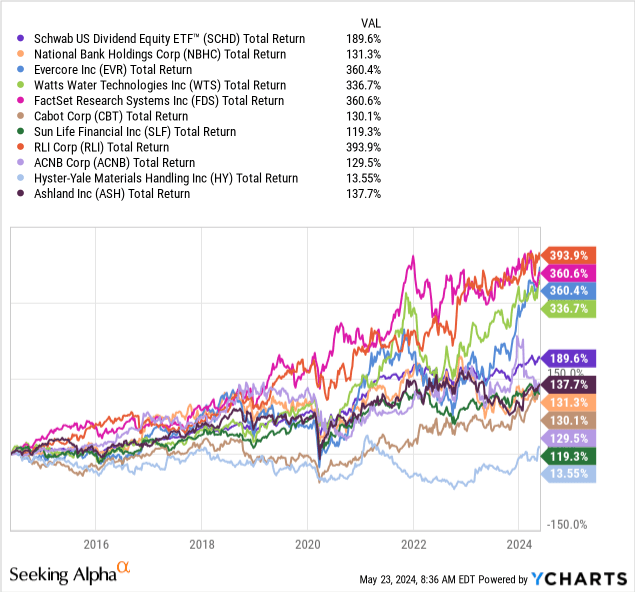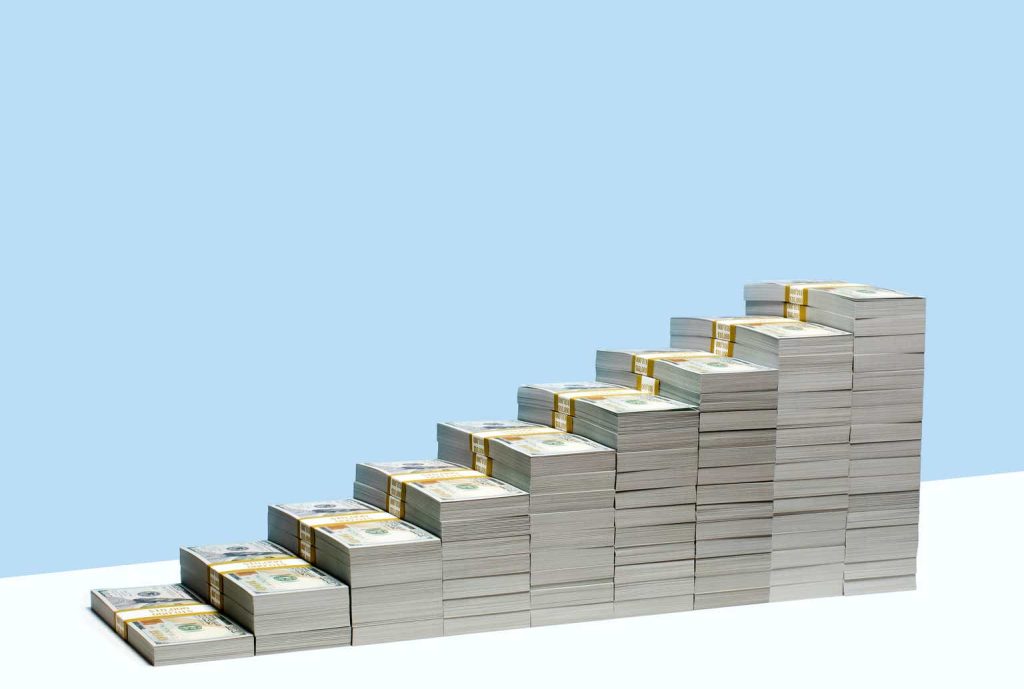Hi everyone, and welcome back! This week features thirteen more dividend increases for your consideration. We don’t have an anchor with a dividend king this week, but nevertheless, we have an impressive set of companies. Leading the charge is RLI Corp, which now has a 49-year streak and shall become a king next year if they can increase once more. The group has an average increase of 7.2% and a median of 6.1%.
My own investment strategy involves buying and adding companies that consistently increase their dividends. I monitor this information for my own use and can share my findings with the Seeking Alpha crowd. This list can help you make smart investment choices and create a successful long-term portfolio.
How I Created The Lists
The following information is a result of merging two sources of data: the “U.S. Dividend Champions” spreadsheet from a particular website and upcoming dividend data from NASDAQ. This process combines data on companies with a consistent dividend growth history with future dividend payments. It’s important to understand that all companies included in this list have consistently grown their dividends for at least five years.
To be included in this list, companies must have higher total yearly dividends. Therefore, a company may not increase its dividend every calendar year, but the total annual dividend can still grow.
What Is The Ex-Dividend Date?
The ex-dividend date is the last day you can purchase shares to qualify for an upcoming dividend or distribution. To be eligible, you must have bought the shares by the end of the preceding business day. For instance, if the ex-dividend date is Tuesday, you must have acquired the shares by the market close on Monday. If the ex-dividend date falls on a Monday (or a Tuesday following a holiday on Monday), you must have purchased the shares by the previous Friday.
Dividend Streak Categories
Here are the definitions of the streak categories, as I’ll use them throughout the piece.
- King: 50+ years.
- Champion/Aristocrat: 25+ years.
- Contender: 10-24 years.
- Challenger: 5+ years.
| Category | Count |
| King | 0 |
| Champion | 2 |
| Contender | 5 |
| Challenger | 6 |
The Dividend Increases List
Data was sorted by the ex-dividend date (ascending) and then by the streak (descending):
| Name | Ticker | Streak | Forward Yield | Ex-Div Date | Increase Percent | Streak Category |
| Sun Life Financial Inc. | (SLF) | 9 | 6.38 | 29-May-24 | 1.20% | Challenger |
| RLI Corp. Common Stock (DE) | (RLI) | 49 | 0.79 | 31-May-24 | 7.41% | Champion |
| FactSet Research Systems Inc. | (FDS) | 26 | 0.93 | 31-May-24 | 6.12% | Champion |
| Evercore Inc. Class A | (EVR) | 18 | 1.58 | 31-May-24 | 5.26% | Contender |
| Cabot Corporation | (CBT) | 13 | 1.7 | 31-May-24 | 7.50% | Contender |
| Watts Water Technologies, Inc. Class A | (WTS) | 12 | 0.8 | 31-May-24 | 19.44% | Contender |
| Hyster-Yale Materials Handling, Inc. Class A | (HY) | 12 | 1.85 | 31-May-24 | 7.69% | Contender |
| Advanced Drainage Systems, Inc. | (WMS) | 10 | 0.36 | 31-May-24 | 14.29% | Contender |
| National Bank Holdings Corporation | (NBHC) | 9 | 3.03 | 31-May-24 | 3.70% | Challenger |
| Hamilton Beach Brands Holding Company Class A Common Stock | (HBB) | 7 | 2.43 | 31-May-24 | 4.55% | Challenger |
| ACNB Corporation | (ACNB) | 7 | 3.94 | 31-May-24 | 6.67% | Challenger |
| NACCO Industries, Inc. | (NC) | 6 | 2.85 | 31-May-24 | 4.59% | Challenger |
| Ashland Inc. | (ASH) | 6 | 1.63 | 31-May-24 | 5.19% | Challenger |
Field Definitions
Streak: Years of dividend growth history are sourced from the U.S. Dividend Champions spreadsheet.
Forward Yield: The payout rate is calculated by dividing the new payout rate by the current share price.
Ex-Dividend Date: This is the date you need to own the stock.
Increase Percent: The percent increase.
Streak Category: This is the company’s overall dividend history classification.
Show Me The Money
Here is a table that shows the new and old rates and the percentage increase. The table is sorted by ex-dividend day in ascending order and dividend streak in descending order.
| Ticker | Old Rate | New Rate | Increase Percent |
| SLF | 0.581 | 0.588 | 1.20% |
| RLI | 0.27 | 0.29 | 7.41% |
| FDS | 0.98 | 1.04 | 6.12% |
| EVR | 0.76 | 0.8 | 5.26% |
| CBT | 0.4 | 0.43 | 7.50% |
| WTS | 0.36 | 0.43 | 19.44% |
| HY | 0.325 | 0.35 | 7.69% |
| WMS | 0.14 | 0.16 | 14.29% |
| NBHC | 0.27 | 0.28 | 3.70% |
| ACNB | 0.3 | 0.32 | 6.67% |
| HBB | 0.11 | 0.115 | 4.55% |
| NC | 0.218 | 0.228 | 4.59% |
| ASH | 0.385 | 0.405 | 5.19% |
Additional Metrics
Some different metrics related to these companies include yearly pricing action and the P/E ratio. The table is sorted the same way as the table above.
| Ticker | Current Price | 52 Week Low | 52 Week High | PE Ratio | % Off Low | % Off High |
| SLF | 50.75 | 43.61 | 55.46 | 14.93 | 16% Off Low | 9% Off High |
| RLI | 147.41 | 120.76 | 149.2 | 35.67 | 22% Off Low | 1% Off High |
| FDS | 447.9 | 378.47 | 488.64 | 33.5 | 18% Off Low | 8% Off High |
| EVR | 201.97 | 104.03 | 206.32 | 17.09 | 94% Off Low | 2% Off High |
| CBT | 101.29 | 62.73 | 103.49 | 37.12 | 61% Off Low | 2% Off High |
| HY | 75.71 | 38.03 | 79.66 | 34.61 | 99% Off Low | 5% Off High |
| WTS | 213.69 | 155.98 | 219.12 | 33.9 | 37% Off Low | 2% Off High |
| WMS | 177.07 | 92.74 | 184.27 | 37.11 | 91% Off Low | 4% Off High |
| NBHC | 37.02 | 27.92 | 38.4 | 13.17 | 33% Off Low | 4% Off High |
| HBB | 18.93 | 8.92 | 25.24 | 10.18 | 112% Off Low | 25% Off High |
| ACNB | 32.47 | 27.58 | 47.75 | 13.56 | 18% Off Low | 32% Off High |
| NC | 31.91 | 27.26 | 38.41 | 7.75 | 17% Off Low | 17% Off High |
| ASH | 99.6 | 70.18 | 100.99 | 0 | 42% Off Low | 1% Off High |
Tickers By Yield And Growth Rates
I’ve arranged the table in descending order so investors can prioritize the current yield. As a bonus, the table also features some historical dividend growth rates. Moreover, I have incorporated the “Chowder Rule,” which is the sum of the current yield and the five-year dividend growth rate.
| Ticker | Yield | 1 Yr DG | 3 Yr DG | 5 Yr DG | 10 Yr DG | Chowder Rule |
| SLF | 6.38 | 5.2 | 10.5 | 8.7 | 5.2 | 15 |
| ACNB | 3.94 | 7.4 | 5.1 | 4.8 | 4.3 | 8.8 |
| NBHC | 3.03 | 10.4 | 9.4 | 11.3 | 18.2 | 14.3 |
| NC | 2.85 | 4.8 | 4.2 | 5.7 | -1.4 | 8.6 |
| HBB | 2.43 | 4.8 | 5.5 | 5.3 | 7.7 | |
| HY | 1.85 | 0.8 | 0.8 | 1 | 2.7 | 2.9 |
| CBT | 1.7 | 8.1 | 4.6 | 3.9 | 7.2 | 5.6 |
| ASH | 1.63 | 14.9 | 11.9 | 9 | 1.3 | 10.6 |
| EVR | 1.58 | 5.6 | 8.5 | 8.7 | 12.5 | 10.3 |
| FDS | 0.93 | 10.1 | 8.4 | 8.9 | 10.9 | 9.8 |
| WTS | 0.8 | 20 | 16.1 | 11.4 | 10.7 | 12.2 |
| RLI | 0.79 | 3.9 | 4 | 4.2 | 4.7 | 5 |
| WMS | 0.36 | 16.7 | 15.9 | 11.9 | 12.3 |
Historical Returns
My investment approach involves identifying stocks that consistently outperform the market while increasing their dividend payouts. I use the Schwab U.S. Dividend Equity ETF (SCHD) as a benchmark to gauge performance. SCHD has a strong track record of exceptional performance, offers a higher yield than the S&P 500, and has consistently grown its dividends. If a stock cannot outperform this benchmark, I prefer to invest in the ETF. I have selected several companies for my personal investment portfolio using this analysis. Additionally, I rely on this analysis to make well-timed additional purchases for my portfolio.
The ten-year dividend growth rate is one of the four main factors in the index behind SCHD. It’s also a proxy for success, although it’s not a perfect predictor. Share prices tend to follow strong dividend growth over long periods. Here’s a comparison of SCHD versus everyone on the list.

SCHD returned about 190% over the past decade (dividends are reinvested in all these results). However, its performance has struggled heavily in the past several years, with inflation and safe interest rates climbing past its own yield.
In any event, there’s a strong tranche of companies at the top of the list. RLI (394%), FDS (361%), EVR (360%), and WTS (337%) all dramatically outperformed SCHD. Those companies seem to have a secret sauce, allowing strong business performance over time. That outperformance is not a recent fad; you can also see the lines near the top in earlier years.
Unfortunately, you dramatically underperformed if your company name wasn’t mentioned in that first group. Like the first group, many of these companies have been serial laggards.
Next Steps
After reviewing the stats for each company and total return performance, I’ve decided to investigate a few companies further. I was most impressed by the four at the top of the list: RLI, FDS, EVR, and WTS. Based on my own criteria, I’m looking for companies with a history of outperforming what I consider to be the benchmark dividend growth ETF of SCHD. I’ve been burned in the past by bottom-fishing or paying far too close attention to current yield, missing the “forest for the trees,” if you will.
The only problem, at first blush, is yield is nowhere to be found. EVR clocks in at the highest with a 1.6% yield, so it will be quite some time before any of these will truly offer a meaningful income stream. I have quite a long horizon, so that’s not necessarily an issue; it’s just something to be aware of.
That group also spans a distance from dividend streaks from 12 (WTS) to 49 years (RLI). In any event, these are the ones I plan to focus on more closely after producing the content for this article. Let me know what you think of my strategy, and feel free to add yours in the comments below!
As always, please do your due diligence before making any investment decision.
Editor’s Note: This article discusses one or more securities that do not trade on a major U.S. exchange. Please be aware of the risks associated with these stocks.
Read the full article here















